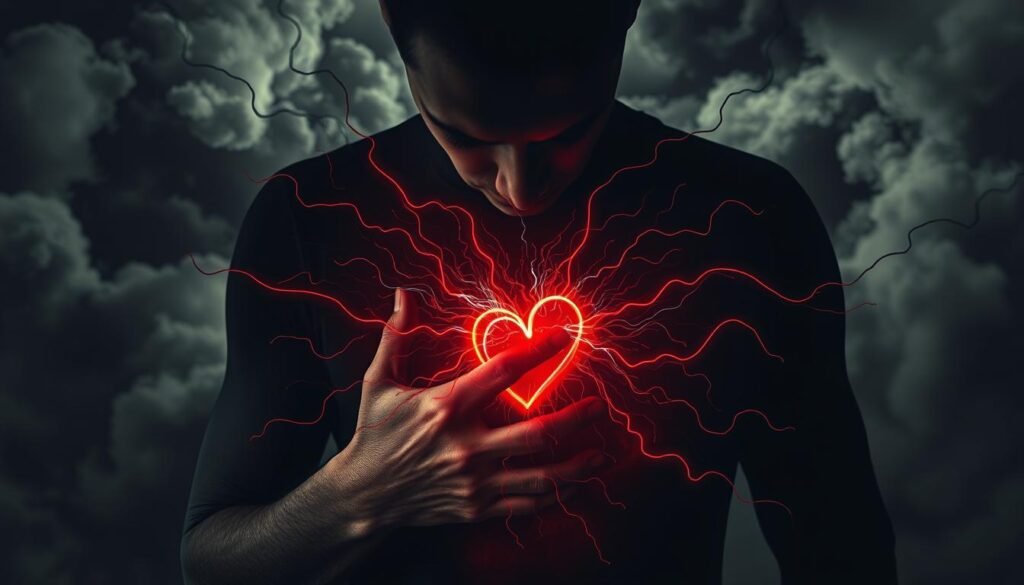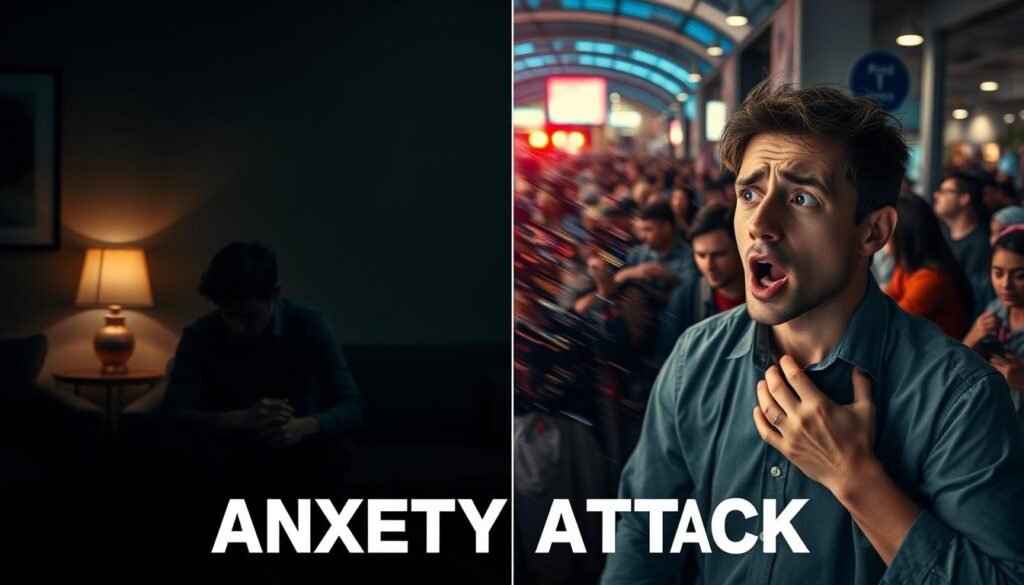About 40 million American adults battle an anxiety disorder. This number shows how widespread anxiety is. It also brings to light the intense stress many face. Knowing how an anxiety attack feels helps us recognize its symptoms. These symptoms can include feeling dizzy, getting nauseous, having a fast heartbeat, and sensing looming disaster. Though not clinically classified by the DSM, the effects of anxiety attacks are seriously disruptive.
It’s vital to identify what anxiety attacks feel like. This awareness helps people get the right help and tell anxiety attacks apart from panic attacks. Experiencing an anxiety attack involves your heart pounding and a loss of control. However, grasping this reality is the first step towards managing it better.
Key Takeaways
- Anxiety attacks can manifest with symptoms like dizziness, nausea, and rapid heart rate.
- They often leave individuals feeling a sense of impending doom.
- Understanding anxiety attack symptoms is essential for seeking help.
- Recognizing the difference between anxiety attacks and panic attacks is important.
- Many people avoid situations fearing anxiety triggers.
Understanding Anxiety and Panic Attacks
Anxiety and panic attacks are different but often overlap. Anxiety involves a lot of worry about what will happen in the future. People feel tired, very alert, or easily annoyed. These feelings can last a long time and make daily life hard. Many suffer from generalized anxiety disorder. Here, worrying doesn’t stop for at least six months.
Panic attacks come on suddenly and are filled with fear or discomfort. They make your heart race, your breath short, and you might feel dizzy. Though they don’t last long, usually under 30 minutes, they’re very intense. Panic attacks can happen now and then and feel more overwhelming than ongoing anxiety.
Knowing the difference between anxiety and panic is key to treating them right. Some folks only have one type, but others might face both. Treating anxiety might mean learning new ways to think and act, or changing your lifestyle. For panic attacks, the focus is on handling sudden scary feelings, reducing sensitivity to those feelings, and understanding your body’s alarm system.
| Aspect | Anxiety | Panic Attacks |
|---|---|---|
| Duration | Chronic, can last for months or years | Short, typically fewer than 30 minutes |
| Onset | Gradual, often linked to stress | Sudden, can occur unexpectedly |
| Typical Symptoms | Worry, fatigue, irritability, muscle tension | Rapid heartbeat, sweating, dizziness, fear of losing control |
| Triggers | Chronic stressors, excessive worrying | External stressors or can be unexpected |
What Does an Anxiety Attack Feel Like?
Knowing what experiencing an anxiety attack feels like is key. It helps in recognizing symptoms and getting help. At first, a person might worry a lot about certain events or dangers. Feelings of dread grow, and physical signs start to show, causing distress.
The common signs of anxiety attack sensations include a fast heartbeat, quick breathing, and nausea. You might also feel restless, easily annoyed, or have trouble focusing. The struggle with how does an anxiety attack feel can be very hard. People often worry they’re losing control or have a serious health issue.
It’s important to know these signs. They help people deal with attacks better. It also helps to tell when a friend or family member might have an anxiety attack. This encourages them to share their worries. Support and understanding are key in getting through anxiety attacks.
If symptoms seem too hard to handle, it’s critical to seek professional advice. A healthcare provider can offer helpful resources and treatments. For more details, here’s a link.
How Does an Anxiety Attack Feel?
Anxiety attacks bring a mix of difficult feelings and sensations. It’s important to recognize these experiences to deal with them effectively. They show up as physical and emotional symptoms, driving people to look for relief and understanding.
Physical Symptoms of an Anxiety Attack
Anxiety attacks bring strong physical symptoms. People may feel:
- Dizziness and lightheadedness
- Excessive sweating
- Headaches
- Rapid heart rate or palpitations
- Gastrointestinal distress
These symptoms can make someone feel in great danger, making their anxiety worse. They often resemble serious health issues, which can increase the worry.
Emotional Responses During an Anxiety Attack
Emotional responses during an attack are major. People often feel:
- Intense fear or panic
- A sense of losing control
- Overwhelming worry about current or past situations
- Feelings of detachment from reality
These emotional issues add to the physical symptoms. It’s vital to know and tackle these feelings.
Common Signs of an Anxiety Attack
Knowing the signs of an anxiety attack is key. Signs include:
- Restlessness or a sense of doom
- Difficulty focusing or feeling mentally foggy
- Sleep issues, like insomnia or bad dreams
- Being very sensitive to sounds or lights
Understanding these signs helps in finding ways to manage anxiety. It aids in dealing with both emotional and physical symptoms of attacks.

| Symptoms | Physical Responses | Emotional Reactions |
|---|---|---|
| Dizziness | Lightheadedness | Panic |
| Heart Palpitations | Accelerated Heart Rate | Fear |
| Gastrointestinal Distress | Nausea | Loss of Control |
| Sweating | Shaking | Detachment |
| Headache | Tension | Overwhelming Worry |
Knowing and understanding these experiences can help people find the right support and coping methods.
Identifying Anxiety Attack Symptoms
Recognizing symptoms of anxiety attacks early helps greatly in managing them. Knowing the difference between panic and anxiety attack symptoms is key. This helps people know how to react properly. Despite their similarities, physical symptoms can lead to confusion.
Physical Symptoms of a Panic Attack
During an anxiety attack, you might feel:
- Rapid heart rate
- Shortness of breath
- Nausea or gastrointestinal distress
- Chest pain or discomfort
- Dizziness or lightheadedness
- Shaking or tremors
These signs can be strong, yet they usually don’t last long. Knowing that these are signs of an anxiety attack can be comforting. It shows it’s not a severe medical issue.
Emotional and Cognitive Symptoms
Anxiety attacks also affect your emotions and thoughts. You might feel:
- Excessive worry or dread
- Feeling of impending doom
- Heightened sensitivity to perceived threats
- Difficulty concentrating and a blank mind
- Feelings of irritability and restlessness
Understanding these signs can motivate someone to get help or use techniques to feel better. Check out this resource for more about anxiety and panic attacks.

Differences Between Anxiety Attacks and Panic Attacks
Differences between anxiety and panic attacks are vital in understanding their nature. Anxiety attacks grow over time and are linked to specific triggers. Panic attacks, however, happen suddenly and are intensely frightening.
Panic attacks are acknowledged in the DSM-5, unlike anxiety attacks. They have at least four specific symptoms, such as chest pain. These symptoms can disrupt daily life, causing people to avoid situations they fear may trigger another attack.
To illustrate the contrasts, consider the following table that outlines key differences:
| Aspect | Anxiety Attacks | Panic Attacks |
|---|---|---|
| Duration | Can last for months | Typically lasts 5 to 30 minutes |
| Onset | Gradual onset, often triggered | Sudden onset, can occur unexpectedly |
| Symptoms Intensity | Milder and less intense | Intense physical and cognitive symptoms |
| Common Triggers | Specific situations or stressors | Can occur without clear triggers |
| Diagnostic Recognition | Not officially recognized | Key feature in Panic Disorder |
| Example Symptoms | Restlessness, irritability | Racing heartbeat, feelings of doom |
Knowing these differences helps individuals understand what they’re experiencing. Treatments like cognitive-behavioral therapy (CBT) and exposure therapy are effective. For more info, visit this site.

Effects of Anxiety Attacks on Daily Life
Anxiety attacks deeply affect daily life. They change how people engage in relationships and social situations. If someone has an anxiety attack, they might pull away from others. This can lead to feeling isolated. It can damage friendships and make forming new connections tough.
Impact on Relationships
Anxiety attacks can hurt relationships badly. Common effects include:
- Increased misunderstandings between partners or friends.
- A tendency to avoid social gatherings, leading to a sense of loneliness.
- Difficulty in expressing feelings or needs appropriately.
Such issues can lead to frustration. Good communication and understanding are key. Support from friends and family is important too.
Effects on Work and Social Life
Anxiety can also affect work life. It can make people worry about having an attack in important situations. This fear may lower their work quality. It might make meeting job expectations hard. Long-term, this can result in:
- Increased absenteeism due to the need to manage anxiety.
- Struggles with concentration, which can affect job performance.
- A lack of social interaction with colleagues, contributing to a stressful work environment.
Anxiety attacks can lower your quality of life. Finding ways to cope and getting treatment are vital. They help you manage better and improve your life.
Experiencing an Anxiety Attack: First-Person Accounts
People who’ve had an anxiety attack share deep insights. One 27-year-old described it as intense fear and anxiety. They felt like they were losing their mind and feared they might pass out.
Many fear others seeing their anxiety attack. This worry about losing control can make the experience worse. It may indicate bigger issues like panic disorder.
Panic attacks have symptoms like heart racing, sweating, and fear of dying, says DSM-5-TR. Stressful situations can trigger these for anyone. People with anxiety may face greater risks.
Changes in life, family anxiety history, and stress can make panic attacks more likely. Overstimulation or feeling trapped can cause symptoms like dizziness. These show how connected our minds and bodies are during such times.
Panic attacks can feel very scary and isolating. Recognizing that about 31% of adults are affected helps share experiences. It’s important to know that help is available and nobody is alone.
| Symptoms | Manifestations |
|---|---|
| Heart Palpitations | Feeling of a racing heart or pounding |
| Sweating | Excessive perspiration even in cool environments |
| Shaking | Tremors in limbs or body |
| Nausea | Stomach discomfort and queasiness |
| Choking Sensation | Feeling of tightness or difficulty breathing |
| Intense Fear | Overwhelming sensation of doom or fear of death |
| Dizziness | Feeling lightheaded or faint |
| Sensation of Numbness | Loss of feeling in parts of the body |
Treatment Options for Anxiety and Panic Attacks
Knowing how to manage anxiety and panic attacks is crucial. Many people face symptoms that interrupt their lives. It’s important to seek treatment for anxiety attacks, which often includes therapy, medicines, and changes in lifestyle.
Cognitive Behavioral Therapy (CBT) is often the first step. It works to switch negative thinking and improve coping skills. Studies show that symptoms often lessen after a few months of CBT. Resources like treatment options for anxiety disorders can provide additional guidance.
Medications can be key in handling anxiety. SSRIs and SNRIs are widely used. For quick relief, benzodiazepines might help, but there’s a risk of becoming dependent on them.
Lifestyle changes also play a big part in managing anxiety symptoms. Cutting out caffeine and alcohol, practicing relaxation, and exercising can help. Joining support groups can also offer comfort and understanding to those struggling.
Often, a mix of treatments works best. Finding the right approach may take some time. Keeping track of symptoms and triggers helps during visits to the doctor. Over time, with the right help and strategies, overcoming these issues is possible.
| Treatment Type | Description | Common Examples |
|---|---|---|
| Psychotherapy | Helps individuals change negative thought patterns and develop coping strategies. | Cognitive Behavioral Therapy (CBT) |
| Medications | Can alleviate symptoms and improve quality of life. | SSRIs and SNRIs |
| Benzodiazepines | Provides quick relief from panic attacks but may lead to dependency. | Alprazolam, Clonazepam |
| Self-Care Strategies | Involves personal techniques to manage stress and anxiety levels. | Relaxation techniques, support groups |
Conclusion
Understanding anxiety attacks is key to dealing with them. Many people ask, “What does an anxiety attack feel like?” The feelings are strong and can leave one feeling lost and scared. Symptoms such as a racing heart, feeling dizzy, and breathing too fast can disrupt life if not handled.
Not getting help can lead to a panic disorder. This can greatly affect one’s life quality.
Learning about treatments like cognitive behavioral therapy (CBT) helps with recovery. Healthy habits, like eating right and exercising, also relieve symptoms. Writing in a diary and connecting with others can make one feel less alone. This resource offers more info on panic attacks.
Treating anxiety attacks from all angles is crucial. It sets a strong support base, aiding recovery and improving mental health. Whether it’s therapy, support groups, or self-care, getting help is key to overcoming anxiety disorders.